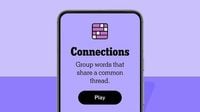Every morning, a growing legion of word puzzle enthusiasts wakes up eager to tackle the New York Times’ Connections game—a daily challenge that’s become as much a ritual as the crossword or Wordle. On September 2, 2025, puzzle #814 delivered a particularly memorable set of categories, sparking both delight and head-scratching among players, and igniting lively discussions across forums and social media. But what exactly made this puzzle stand out, and how did it connect with broader trends in the puzzle world?
For those unfamiliar, Connections is a word association game in which players are presented with a grid of 16 words or phrases. The goal? Sort them into four groups of four, with each group sharing a hidden connection. It sounds simple, but the game’s editors delight in throwing curveballs—sometimes through clever wordplay, sometimes by drawing on pop culture or grammar quirks. As The New York Times itself notes, the puzzles are released at midnight in every time zone, ensuring a global, simultaneous brain-teaser for players everywhere.
On the morning of September 2, the Connections puzzle presented four distinct categories, each with its own flavor and level of difficulty. According to Lifehacker, the day’s categories were:
- Yellow: CURSES (expletives, four-letter words, profanity, swearing)
- Green: IN “A VISIT FROM ST. NICHOLAS” (Christmas, house, mouse, stirring)
- Blue: WORN BY EARRING MAGIC KEN (earring, mesh shirt, necklace, pleather vest)
- Purple: STARTING WITH POSSESSIVE DETERMINERS (herring, histamine, mystery, ouroboros)
Let’s break down each category, exploring both the answers and the cultural or linguistic threads that tie them together.
The yellow group, CURSES, was perhaps the most straightforward—at least at first glance. Words like “expletives,” “four-letter words,” “profanity,” and “swearing” all evoke taboo language, the kind of thing a parent might scold a child for uttering. As Lifehacker put it, “Things a kid shouldn’t say.” It’s the sort of group that rewards players with a keen sense of the obvious, but also those who can spot subtle synonyms.
The green group, IN “A VISIT FROM ST. NICHOLAS,” offered a dash of seasonal nostalgia. The words “Christmas,” “house,” “mouse,” and “stirring” are all lifted straight from the classic holiday poem—better known by its famous opening line, “’Twas the night before Christmas.” According to CNET, recognizing this literary reference could make the group a breeze for those familiar with the poem, but a challenge for others. One hint from Lifehacker nudged players: “If you can think of a classic poem about Christmas, you’ll have an easier time finding what else goes with that word.”
Things got more colorful—literally and figuratively—with the blue category: WORN BY EARRING MAGIC KEN. This group included “earring,” “mesh shirt,” “necklace,” and “pleather vest.” To the uninitiated, the connection might seem baffling. But as CNET gleefully explained, this was a nod to a short-lived 1993 Ken doll, infamously dubbed “Earring Magic Ken.” The doll, with his edgy wardrobe and iconic accessories, quickly became a pop culture legend (and, as some note, a camp icon in LGBTQ+ circles). “A retro pal for Barbie and possibly the best Connections category ever,” CNET remarked, highlighting the playful spirit behind the puzzle’s design. For those in the know, this group was a delightful wink; for others, perhaps a prompt to dive into a quirky chapter of toy history.
But the purple group—STARTING WITH POSSESSIVE DETERMINERS—was where many players hit a wall. The words “herring,” “histamine,” “mystery,” and “ouroboros” don’t seem to have much in common at first glance. The trick? Each word begins with a sound that matches a possessive determiner: “her” in herring, “his” in histamine, “my” in mystery, and “our” in ouroboros. As Lifehacker explained, “It starts with the possessive ‘her,’ and that fits with ouroboros (our), histamine (his), and mystery (my).” This sort of wordplay—where the connection is buried in the phonetic structure of each word—epitomizes the puzzle’s most fiendish side. Even seasoned solvers, including self-proclaimed English majors, admitted to being stumped. “Don’t even go there with the purple category,” one CNET contributor joked, confessing that their English degree hadn’t prepared them for this particular twist.
The difficulty of the puzzle was officially rated at 2.8 out of 5 by the New York Times’ own testers, placing it slightly above average in terms of challenge. According to the Connections Companion published by the Times, the purple group was “the most difficult,” while yellow was “the simplest.” But as any Connections player knows, perceived difficulty can be highly personal—what’s obvious to one solver might be utterly opaque to another.
Beyond the puzzle itself, the Connections community is thriving. The Times now offers a Connections Bot, similar to the one for Wordle, which allows registered players to track their progress, win rates, and streaks. Forums and comment sections buzz with players sharing their daily solve grids, lamenting tricky categories, and celebrating perfect scores. According to The New York Times, players are invited to email feedback, join Instagram for behind-the-scenes content, and even rate each puzzle’s difficulty. The sense of camaraderie—and competition—is palpable.
It’s worth noting that Connections is just one piece of a larger puzzle renaissance. Word games like Wordle, Strands, and the Mini Crossword have all found massive audiences, thanks in part to their daily format and shareable results. As Lifehacker and CNET both suggest, many players now make Connections part of their daily routine, often alongside these other games. The multi-colored squares that players share on social media have become a new kind of digital badge, instantly recognizable to fellow fans.
So why do puzzles like Connections resonate so deeply? Perhaps it’s the blend of logic, language, and surprise. Each day brings a fresh set of challenges—sometimes rooted in literature, sometimes in pop culture, sometimes in the quirks of English itself. And as puzzle #814 proved, the best Connections are the ones that make us laugh, groan, and—just occasionally—learn something new about the words we use every day.




